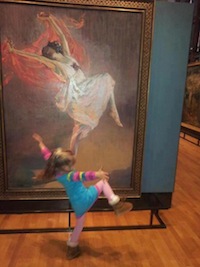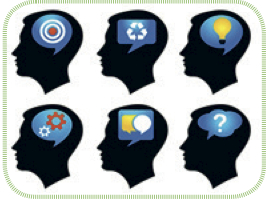Introduction
One vital aspect of modelling rarely made explicit is the perspective adopted by the modeller when modelling an exemplar for an ability, behaviour, state, belief, etc. There are a surprisingly large number of modeller perspectives to choose from. This blog describes six.
Penny Tompkins and I use ‘perspective’ rather than the traditional NLP term ‘perceptual position’ since there is more to a perspective than adopting one of the ‘first’, ‘second’ or ‘third’ positions. (For a general exploration of perspective see our article: Multiple Perceptions, Perspectives and Perceivers [Link available soon]).
The most common and direct way to describe a perspective is through metaphor. Paradoxically, one of the best ways to grasp something as subjective as perspective is to take the descriptive metaphor ‘literally’, i.e. to physically embody it. It also helps to distinguish between a variety of modelling perspectives.
Many leading modeller’s have developed their own modelling process and each one requires the modeller to shift to a different perspective to undertake the modelling. I’ll examine six of the better known methodologies for the perspective the developer adopts when using their methodology. (For a longer list of modelling methodologies see Section 10 of How to do a Modelling Project. [Link available soon])
Each of the five-stages of a modelling project requires the modeller to adopt a different perspective, I will limit this blog to those used during ‘information gathering’ since that is where the distinctions are clearest.
I want to emphasise that although I use the expert modellers’ own metaphors, these are my models of what they do; they may well have other ways of describing their approach.
Six Modelling Methodologies
I have used our sensory, conceptual, symbolic distinctions to classify six modelling methodologies used by
expert modellers. Each one has a different modelling perspective which can be described as follows in table 1:
| Category | Modelling Methodology | Expert Modeller | Modeller’s Perspective |
| Sensory | Original NLP Modelling Generative Trance | John Grinder Steve Gilligan | Unconscious uptake/assimilation Deep trance identification |
| Conceptual | Analytic Modelling Experiential Array Sub-modality Modelling | Robert Dilts Gordon & Dawes Richard Bandler | Take on Step in and try on Teach me to be you |
| Symbolic (Metaphoric) | Symbolic Modelling | Lawley & Tompkins | Facilitating self-modelling |
Since they are aiming to achieve a similar end, the six methodologies share many features. For example, they all use an inductive approach that aims to construct a model (consciously or unconsciously) of how something works based on observations of the data (i.e. from the bottom up). They aim to discover something new rather than attempt to prove or disprove a hypothesis.1 All six perspectives deliberately resist forming assumptions before they interact with the exemplar. However, modellers use a variety of metaphors to describe how they:
Set aside their map
Start with a clean slate
Empty their mind
Access a know-nothing (nerk-nerk) state
Adopt a Zen mind
Have a child-like curiosity
Get very still and quiet inside
Get their ego out of the way
While there are other similarities, by examining the differences between the perspectives the range and variety becomes apparent. Two keys to understanding the differences are: (i) the relationship – and especially the spatial relationship – the modeller has with the exemplar’s model of what they do; and (ii) how the modeller uses their body as part of their modelling. These distinctions, among others, are discussed below.

(Photography by Kirsty Kelly (KLK Photography Lanarkshire) of her daughter inspired by the painting of Anna Pavlova by John Lavery, 1911)
Note the young girl is modelling by mirroring rather then modelling from the dancer’s perspective. Maybe she is modelling from the artist’s perspective.
Six Modelling Perspectives for Gathering Information
Table 2 below summarises and compares each of the six modelling perspectives for:
(a) The role of the exemplar
(b) What is primarily modelled
(c) Where and how the modeller creates a model of the exemplar’s model
| Modeller’s Perspective | Role of Exemplar | What is primarily modelled | Where/how modeller creates their model |
| Unconscious uptake/assimilation | No active part | External behaviour in a typical context | Unconsciously in the body and mind of the modeller |
| Deep trance identification | No active part | Identity (become the exemplar) | Unconsciously as if they are the body and mind of the exemplar |
| Take on | Describes his or her experience and verifies modeller’s model | Internal process and external behaviour during interview | Consciously in the mind and body of the modeller |
| Step in and try on | Describes his or her experience and verifies modeller’s model | Internal behaviours, criteria and beliefs | Between modeller and exemplar – the modeller then steps into the model, tries it on and steps out |
| Teach me to be you | Explains to modeller how to do what they do | Internal process and sub-modalities | Consciously in the mind of the modeller |
| Facilitating self-modelling | Self-models, i.e. they create and describe a metaphor landscape in and around them self. | Organisation of verbal and nonverbal metaphors | In and around the exemplar maintaining the exemplar’s perspective |
I will now overview each of the six modelling perspectives compared in table 2 above.
Unconscious uptake (Grinder)
While in a state of wide peripheral vision, no internal dialogue and mild trance, the modeller observes the exemplar doing the expertise. The modeller maintains this state while observing and uses his or her body to imitate the exemplar with micro-muscular movements. Through a process of “unconscious uptake” the modeller acquires the external behaviour (and vicariously the internal process) of the exemplar. The modeller’s body and unconscious mind take in or absorb whatever the exemplar does without any censorship. They are a sponge-like vessel which, through the imitating process, acquires the behavioural patterns of the exemplar.
In spatial terms, the external behaviour and and internal states of the exemplar are transferred to the modeller’s body and mind without conscious awareness. Later on the modeller can consciously decode the acquired patterns by self-modelling and then re-code these into a formal model if required.
Deep trance identification (Gilligan)
“Deep trance identification is a hypnotic process wherein a person develops a deep trance, goes into a safe place, sets aside their regular personality, and assumes another personality for 30 minutes or so.”2Similar in some ways to unconscious uptake, “deep trance identification” minimises the role of the conscious mind and involves trance. The difference is that the modeller (after making suitable agreements with him or her self) aims to become the exemplar. Sometimes known as ‘full second-position modelling’ or “field-based modeling” the modeller aims to put themselves fully within the mind and body of the exemplar, experiencing all that the exemplar experiences. They can do this either in the presence of the exemplar or not.
In spatial terms, the modeller acts as if their body and mind goes into the body and mind of the exemplar to experience life entirely from that perspective.
Take on (Dilts)3
Robert Dilts consciously constructs his model of the exemplar’s model in his own body and his own mind-space bit by bit. As he does this he “takes on” the internal and external patterns of the exemplar, i.e. he uses the exemplar’s verbal and nonverbal answers to his questions to replicate in himself the essential elements and processes. These are regularly recapitulated back to the exemplar as a test for congruence between Dilts’ description of his model and the exemplar’s experience.
In this way, the model to be acquired is consciously transferred from the exemplar and reconstructed within and around the modeller.
Step in and try on (Gordon & Dawes)4
David Gordon asks questions and gathers information from his exemplar so he can construct a representation of his exemplar’s model between him and the exemplar. Every now and then he “steps in” (sometimes physically taking a step forward), “tries on” his model to get a sense of it from the inside, and allows the exemplar’s descriptions to “take over” his body and “guide the reorganizing” of his experience. Having done this he steps back and uses his experience from having stepped in to continue to ask questions and build his model.
In spatial terms, the modeller constructs a model between himself and the exemplar and then repeatedly steps in and steps out of that model.
Teach me to be you (Bandler)
When the modeller says to the exemplar “If I was going to fill in for you” or “Teach me to be you” an interesting shift of perspective occurs. The exemplar has to change from just doing what they do, to explaining how they do it to someone else. The modeller listens to the descriptions, does in their mind as much of the process as they can, and asks the exemplar to fill in any gaps. The modeller constructs a more or less content-free model and uses ‘I’ statements when summarising their model.5
“You collect the information first, by asking questions that get the information, then being sure that you have a way of encoding it to remember it yourself. I do this by building a map, seeing what they’re seeing and saying what they’re saying, and doing what they’re doing, and testing these enough to know that I’ve got it.” 6
Facilitatating self-modelling (Lawley & Tompkins)
The perspective adopted by the symbolic modeller enables the modeller to share the exemplar’s perspective while simultaneously maintaining their own. To do this the modeller facilitates the exemplar to self-model. That is, the exemplar creates own model of the way they do what they do within their mind-body space. Since the exemplar will inevitably use metaphor to do this, we follow David Grove in calling the exemplar’s model a “metaphor landscape”. The exemplar “points out” aspects of his or her inner world, while Clean Language questions “point to” and request elaboration of that landscape. The model is thus created in and around the exemplar by both the exemplar and the modeller.7
At this stage the symbolic modeller does not take on the exemplar’s model in their own body-mind space, instead they use that space to “muse” on the inherent logic and structure of the exemplar’s embodied metaphors. Later, if required, a formal description of the model can be created, tried on and tested by the modeller.8
Two Distinctions
Conscious/Unconscious
I have noticed that even when using conscious modelling methodologies, plenty of unconscious uptake happens at the same time. I regard the debate over the degree of conscious/unconscious modelling as a bit of a distraction. More important to me is when the modeller aims to understand the model they are creating. In sensory/intuitive methodologies it is some time after the information gathering stage. In conceptual/analytic methodologies it is during it. In this regard, if the intuitive and analytic methods are more or less poles apart, Symbolic Modelling sits somewhere in between.
Bottom-up/Top-down
Another way of distinguishing between sensory/intuitive and conceptual/analytic modelling methodologies is to note how much of a pre-existing template or framework is used to organise the information being gathered. Grinder and Gilligan’s methods are “bottom-up” (behaviour to concept) while Dilts, Bandler, Gordon and Dawes are, relatively, more “top-down” since they use previously identified models (e.g. logical levels, perceptual positions, representation systems, submodlaities, belief template, etc.). Again, Symbolic Modelling sits somewhere between the two.9
Concluding Remarks
When I am modelling from any of the perspectives mentioned above, my body-mind state is unlike any of my everyday ways of being and behaving. Modelling feels different. People often think they are modelling when what they are doing is trying to understand from their everyday-sense-making perspective. Everyday understanding is a useful way to learn, and of course it involves a form of modelling, but I maintain it is not the kind of modelling that is the pumping heart that gives life to NLP.
Once a degree of competence has been acquired with each perspective, the modeller gains the flexibility to adopt any of the perspectives depending on the circumstances (context, content and purpose) of the modelling being undertaken. An experienced modeller can go even further – they can consciously switch between a variety of perspectives as the modelling progresses.
For example, when Penny Tompkins and I modelled improvisational clown trainer Vivian Gladwell, we began by observing what he did while he trained people (including us). At times we used unconscious uptake to model Vivian. Later we (with Marian Way) interviewed him. The interview started out fairly conceptual and analytical while Vivian described his beliefs and criteria related to his work. When metaphors spontaneously emerged we switched to Symbolic Modelling.10
Although there are differences between the perspectives, they all share what I call ‘the modeller’s stance’. That is, there is a conscious aim to create a model that, initially at least, is a close replica of the exemplar’s way of being excellent – unencumbered by the modeller’s own assumptions. I hope I have shown that this can be achieved by a variety of modelling perspectives
NOTES
This blog was inspired by Fran Burgess’ laudable new book, The Bumper Bundle Book of Modelling. This mammoth contribution to the field is the result of 15 years observing many leading modellers first-hand. It is the first publication which provides an extensive compilation and comparison of a number of modelling methodologies used in NLP.
References for the methodologies described in this blog can be found at: How to do a modelling project [Link available soon].
1. One example of scientists aiming to prove or disprove a hypothesis was recently reported in the Guardian newspaper. Carles Lalueza-Fox, leader of a study at the Institute of Evolutionary Biology, Barcelona was quoted as saying: “Before we started this work, I had some ideas of what we were going to find.” This is counter to a modeller’s attitude. As it happens, Lalueza-Fox found that “Most of those ideas turned out to be completely wrong.” theguardian.com/science/2014/jan/26/swarthy-blue-eyed-caveman-dna-tooth. NLP modelling can be adapted to the standard deductive scientific method – it’s just not how it was conceived.
2. Gilligan, S. (2011) An interview with Dr Stephen Gilligan by Chris & Jules Collingwood (stephengilligan.com/interviewA.html accessed 21 Oct 2013 link no longer available).
3. There is a short video of Robert Dilts modelling an exemplar in our article on the topic: Modelling Robert Dilts Modelling [Link available soon]
5. This approach is also used as a therapeutic intervention. In teaching the therapist/coach what they do, the client has to take a different perspective on their problem. Having done so, it is not unknown for Richard Bandler to deliberately get it wrong as a way to ‘mess up’ the client’s unproductive strategy (Richard tends to use another, less polite, four-letter term).
6. Richard Bandler in Persuasion Engineering, Richard Bandler & John La Valle p. 147.
7. Pointing to a New Modelling Perspective.
8. A Model of Musing: The Message in a metaphor.
9. Modelling Top-down and Bottom-up. [Link available soon]
10. You can see the results of the modelling of Vivian Gladwell training improvisational clowns at: Coaching in-the-moment. [Link available soon]
Last updated 31 Oct 2018.









